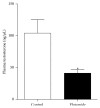Testosterone Depletion Induces Demethylation of Murine Reelin Promoter CpG Dinucleotides: A Preliminary Study
- PMID: 26526966
- PMCID: PMC4615860
- DOI: 10.1155/2015/286369
Testosterone Depletion Induces Demethylation of Murine Reelin Promoter CpG Dinucleotides: A Preliminary Study
Abstract
Schizophrenia (SZ) is a debilitating mental disorder characterized by psychotic events, abnormal social behavior, false beliefs, and auditory hallucinations. Hypermethylation of the promoter region of reelin (RELN), a gene involved in regulation of neuronal positioning during telencephalic development, is strongly associated with low protein expression in several cortical structures and promoter hypermethylation in brain from postmortem SZ subjects. Recent experimental data suggests that testosterone is able to promote RELN demethylation, although no direct evidence of hormonal influence on reelin promoter methylation was obtained. We investigated if reduced levels of plasma testosterone in adult male mice lead to Reln promoter demethylation. Animals were administered with flutamide, an antiandrogenic compound, and reelin promoter methylation was assessed using methylationspecific PCR using bisulfite DNA from cerebellum. We found that flutamide was able to significantly lower plasma testosterone when compared to control mice, and treatment did not influence animal survival and body weight. We also show that low plasma testosterone was associated with demethylation of a cytosine residue located at -860 in reelin promoter region. These preliminary data suggest that androgenic hormones can influence cerebral reelin demethylation. To our knowledge, this is the first experimental approach directly linking testosterone depletion and RELN promoter methylation.
Figures




References
Publication types
MeSH terms
Substances
LinkOut - more resources
Full Text Sources
Other Literature Sources

